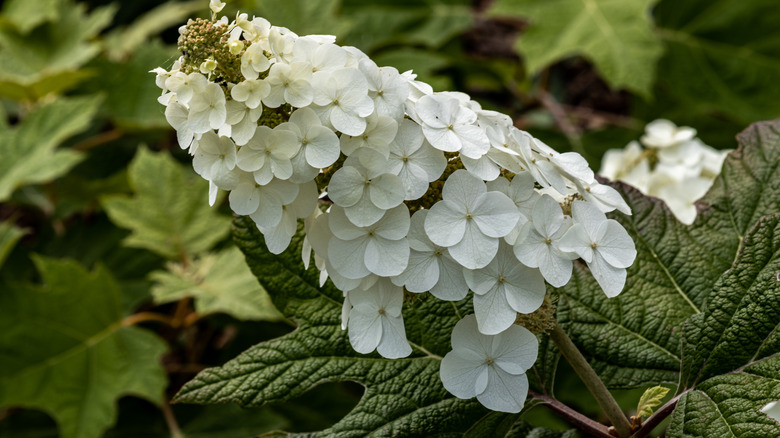If you love hydrangeas but are short on space in your garden, fret no more. Little honey hydrangeas (Hydrangea quercifolia), with their stellar white flowers and chartreuse foliage, are all you need. A member of the hardy oakleaf hydrangea variety, these miniature marvels stand in contrast to their 4 to 6 feet tall counterparts. Their diminutive stature makes them a snug fit for compact areas. They are also fairly easy to maintain and require little pruning if provided with the right growth conditions.
What truly makes little honey hydrangeas charming is how their small size pairs with striking foliage and showy flowers. This can transform your yard into a visual delight without overwhelming the space, as larger hydrangeas would. Also, their branches add visual interest during the winter. While these deciduous shrubs are perfect as informal hedges or flowerbed borders, they fit just right as accent pieces for your patio or around your home’s foundation. They are suitable for container gardening as well.
Defining features of little honey hydrangeas

Branching off of “Pee Wee” hydrangea quercifolia, little honey hydrangeas are a dwarf cultivar with enchanting color-changing foliage and blooms. These woody shrubs grow to a height of 3 to 4 feet and spread around 3 to 5 feet wide. During spring, they develop coarse, golden-yellowish leaves, which mature into pale yellow-greens as the summer ends, adding a touch of sunshine to your landscape. These five-lobed, oak-shaped leaves grow to around 4 to 7 inches in length and have serrated margins. They turn green when fall sets in and finish off the blooming season in crimson red.
But the real appeal of little honey hydrangeas lies in their delicate, enchanting flowers, which bloom in clusters during the early summer months of June and July. These saucer-shaped, four-petaled flowers are initially a pristine white but gain a soft pink tinge as the season unfolds. They can grow to around 5 inches and continue to blossom sporadically through the fall. During winter, the plant’s stem transforms into a showy red hue, which adds visual depth to the lawn.
Caring for little honey hydrangea
Besides its vibrant appearance and compact size, this woody shrub’s allure is enhanced with easy maintenance, making it an ideal choice for both novice and experienced gardeners. This drought-tolerant species performs best in partial shade but can withstand full sun exposure for over six hours. It also prefers well-drained, organically rich, moist soils. However, you must top-dress their soil with a mulch layer during the summer to improve water retention. Also, water the shrubs regularly when they start blooming.
Moreover, the little honey hydrangea grows flowers on the previous year’s growth or old wood. To encourage new growth, prune the damaged stems after the flowering season ends or during early spring. Although honey hydrangeas are hardy in zones 5 to 9, hydrangeas require TLC in winter, especially those growing in zone 5. As the woody shrub loses its buds or dies out when temperatures dip below -10 degrees Fahrenheit, move it to a more sheltered location. When moving is not an option, add an additional mulch layer to the soil and wrap it in burlap. Like other oakleaf hydrangea varieties, the bark of the little honey hydrangea peels off at maturity.